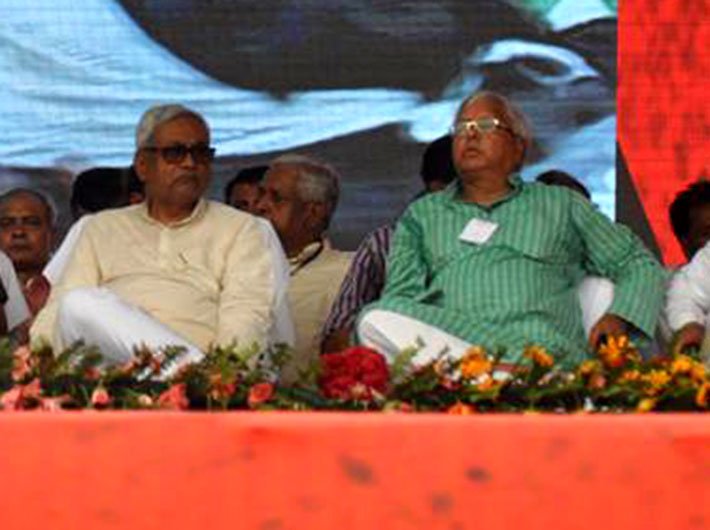The BJP seems to be a wounded tiger, licking its wounds after the Bihar poll drubbing. There will be a lot of blame game within, as to why the party and its allies could not wrest power from the Nitish-Lalu-Congress Mahagathbandhan and what went wrong. It’s time for self-introspection after the blunders.
What was being touted as a close fight or a photo finish turned out to be one-way traffic for the Mahagathbandhan which bagged 178 seats of the total strength of 243 of the Bihar assembly. Lalu Prasad's RJD topped with 80 seats followed by Nitish Kumar's JD(U) getting 71 and Congress with 27 seats. The NDA had to contend with 58 seats with BJP getting 53 seats and its allies LJP and RLSP two each while HAM got one seat.
The BJP secured the highest number votes (93,08,015) as an individual party. Therefore, it was also the party with the single largest vote base with 24.4 percent votes. But its coalition partners LJP, RLSP and HAM could get only 4.8 percent.2.6 and 2.3 percent votes taking the NDA tally to 34.1 percent votes. The NDA was clearly outsmarted by a combined 41.9 percent of the Mahagathbandhan. RJD secured 18.4, JD(U) 16.8 and the Congress 6.7 percent votes. It is interesting mention that the NOTA option (none of the above) button was pressed by 2.5 percent voters of Bihar. This figure is a fraction less than the total votes polled for RLSP and slightly more than the total votes polled for HAM.
The BJP’s first and foremost mistake was overconfidence. Its leaders did not realise that it was dal and onion which would hurt them the most against the backdrop of the ‘Achchhe Din’ slogan. Arhar dal is one commodity which is used in daily meals of every household in Bihar and when its price crosses the Rs 200 mark, coupled with high onion prices, it is bound to hurt voters.
Riding high on the wave of electoral successes in Haryana and Maharashtra, the party in fact forgot that in 1998 assembly elections, it was onion prices that defeated it in Rajasthan and Delhi.
The damage control exercise by the central ministers was not convincing enough for the Bihar voter. Minister of consumer affairs, food and public distribution Ram Vilas Paswan tried to blame the Nitish government for failing to contain the spiralling dal prices, but Nitish Kumar shot back by pointing out that dal was selling at Rs 200 a kg in the BJP-ruled states of Madhya Pradesh, Gujarat, Rajasthan and Maharashtra too.
Maverick Lalu Prasad was quick to comment that “Modi has taken away dal from the poor man's ‘dal roti’.” Both Lalu and Nitish did not forget to rake up this issue at every public meeting, using it as an effective tool against the BJP-led NDA.
There were other reasons as well. The campaign was turned into a ‘Delhi only’ show. The election campaign took off with just two names, prime minister Narendra Modi and BJP national president Amit Shah, who were the poster boys of the party. The state leadership was totally ignored. Those prominent in this list are Sushil Kumar Modi, Nand Kishore Yadav, Bhupendra Yadav, BJP state president Mangal Pandey and vocal MP-film star Shatrughan Sinha.
Ticket distribution was another area where the Bihar leadership was somewhat ignored and the remote control rested in the hands of the central leadership. Veterans in party politics were sidelined to make way for youth with far less experience and fewer ground connections. Party MP RK Singh alleged on a public platform that tickets were being sold. As a result, there were many angry faces of the party who preferred to contest as independents. Though they did not win, they certainly dented the party’s vote bank. To sum it up, ‘the party with a difference’ did not seem to be different from any other party.
Sources say that another grievance of local leaders was that they were not only ignored when it came to posters and banners but were also humiliated and not even allowed on to the stage during the rallies of the top leadership.
Big mouths of the party also did major damage. Unnao MP Sakshi Maharaj said just after the first round of polling in Bihar that the NDA had not done well in the state. Amit Shah was quick to say after the second round of polling that the results of Bihar elections should not be seen as a referendum for Modi. An almost similar statement was made by finance minister Arun Jaitley who said that victory or defeat in Bihar would not affect the central government. These statements were read by the public at large as if the BJP had already thrown the towel in the ring and accepted defeat even before the polling process could finish, leave waiting for the day of counting of the votes.
Another point where the BJP missed in evaluating the ground reality was the popularity of chief minister Nitish Kumar. The party leadership assumed that there would be a strong anti-incumbency against him but on the contrary he turned out to be quite popular with the masses, though there were voices from a section of upper caste voters that it would have been better had he not joined hands with Lalu Prasad and his RJD.
But, politically speaking, Lalu and his party were the need of the hour for Nitish. Thirty-plus percentage of Muslim-Yadav votes rallying strongly behind Lalu was one factor which Nitish could not even imagine of leaving aside. It was this formula of ‘social engineering’ by Nitish which saw him and his Mahagathbandhan, finally emerge victorious.
Electioneering touched a new low this time in Bihar. Many remarks and replies were too gross and below the belt. It started with Modi saying something was wrong with Nitish’s DNA, which the Bihar CM turned into an issue of Bihari Asmita, or pride. And then came the beef controversy. Cow politics touched its peak in the cow belt with Lalu jumping into the fray. He said that even Hindus eat beef, though he later withdrew the remark by saying that “shaitan” put words in his mouth. Modi responded by saying that it was not a shaitan that turned Lalu's tongue but Lalu himself was a shaitan. Known for his theatrics, Lalu shot back by saying that “if I am a shaitan then Modi is a brahmapishach”. Right before the third phase, BJP MP from Navada and union minister Giriraj Singh released a video clip that showed Nitish kissing the hand of a tantrik, after which another battle of words and wits ensued.
But the real game changer was Nitish-Lalu’s great understanding of the caste equation and emulation of Mayawati’s social engineering in Uttar Pradesh in 2007. In 2010 polls, it was Nitish’s own vote base combined with upper caste votes that won him the day, and this time the Muslim-Yadav combination replaced the upper caste votes.
In 2010 elections, the BJP-JD(U) combine had got a massive 86 percent of the total of 15 percent upper caste vote consisting brahmins, rajputs, bhumihars and kayastha voters. Of the 12 percent kurmi and koeri votes, the coalition had got about 56 percent of its votes. It had got a massive 71 percent of mahadalit votes consisting 24 percent of the electorate and 62 percent of the six percent dalit votes. A majority of the Muslims (14.2 percent) and Yadavs (16.5 percent) had gone to the RJD and others. JD(U) had emerged as the largest party, winning 115 of the 141 seats it contested. The BJP had won 91 of the 102 seats it contested. BJP had a better strike rate of 89.22 percent than JD(U) which had a strike rate of 81.56 percent. (Despite lower strike rate JD(U) won more seats as it had contested more seats.) JD(U) topped with 22.61 percent of the total vote share followed by BJP with 16,46 percent votes. In terms of seats, JD(U) had gained 36 seats and BJP 27. Vote swing in favour of JD(U) was 0.81 percent. Nitish had then said that his party had nothing in common with its coalition partner BJP and the decision that Gujarat chief minister Narendra Modi would not campaign in Bihar, was that of the BJP and not his.
Later, Nitish parted ways with the BJP and this time around formed a grand alliance or mahagathbandhan consisting of JD(U), RJD and Congress. He was relying heavily on the Muslim-Yadav combine along with dalit, mahadalit and his traditional kurmi-koeri vote base. And eventually, the traditional vote base of Lalu, the MY (Muslim-Yadav) vote bank has done wonders for him as well as the mahagathbandhan.

